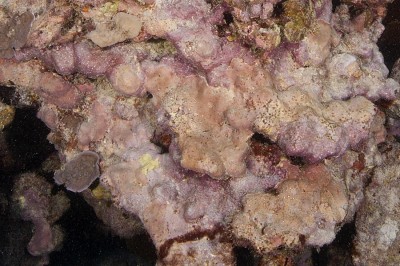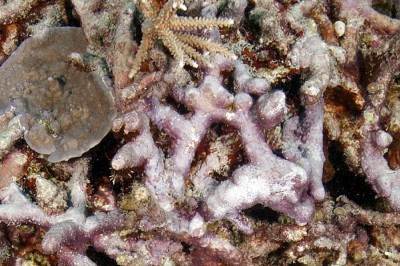With wind and swell building from the south and east, we identified two relatively sheltered sites north of Ile des Pins for the morning surveys. Ominous rain clouds were building in the sky to the east, but we were glad for relatively clear skies at our dive site. After anchoring safely, Scientific Diver Dawn Bailey and I entered the water for the first of what were to be two very different dives.
My task is to conduct surveys of the sea floor. Working at 10 m and 5 m depths, I lay a transect line, which I then swim along to identify the composition of corals, algae, sponges and other biota on the bottom, as well as describing the underlying substrate – hardground, sand, and rubble.
The first site had thick coral cover, especially at the shallower transects, with large thickets of branching Acropora interspersed with smaller corals. After surfacing, we moved about a mile around the corner to the second dive site. This spot had a different aspect, facing southwest rather than north. As we descended on our dive, wide channels (2-10 m) filled with coral rubble were apparent. Reef rubble describes corals and reef structure that have died, broken, or toppled from their growth position and fragmented. Coral rubble can be indicative of a degraded or damaged reef. Much of the rubble we saw likely originated upslope, loosened under the action of large waves and strong currents, and transported downslope by gravity.
Coral Rubble Gives New Life to Reef Fragments, Forming New Substrate from Dead Coral
Though the sight of coral rubble on a reef may seem disheartening, it is also a sign of natural disturbance events. Much of this reef rubble may have been formed when Cyclone Erica swept through Ile des Pins ten years ago. However, in many areas of the dive site, we can see the reef beginning to reform. Large clumps of coral rubble had been fused together by Crustose Coralline Algae, or CCA for short. CCA is a red algae that deposits calcium carbonate (similar to limestone) in its cell walls. The algae grows as a thin sheet atop the surface of rock and dead coral skeleton.

CCA deposits calcium carbonate as a thin sheet atop the surface of rocks and dead coral skeleton.
Though CCA is unassuming in appearance and stature, it has an important role on the reef. The algae cements together adjacent and interlocking reef fragments. This process helps stabilize coral rubble into a consolidated reef framework, which then facilitates the re-colonization of corals and other reef biota. Free swimming coral larvae are able to detect chemicals released by CCA into the water column, and use this as a cue for where to settle.

CCA helps bind coral rubble fragments back into the reef framework. Coral larvae can detect CCA and preferentially settle atop the exposed substrate. Small corals can be seen establishing a foothold on the fused reef fragments.
Though corals were less dense at the second of our two dive sites, we noted many small hard and soft corals, algae, sponges, and tunicates upon these stabilized patches of substrate. While coral reefs appear fragile and can be rendered to reef rubble by the impacts of storm waves, processes such as binding by CCA help stabilize loose reef fragments, facilitate coral settlement, and enable reef recovery.
Photos: 1-2 Ken Marks